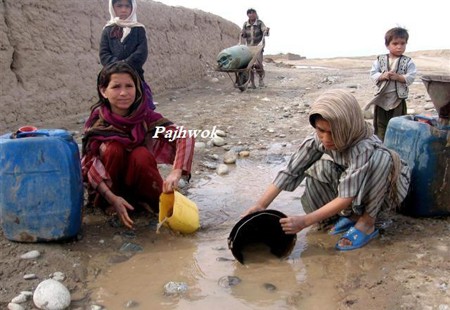Monday, August 31, 2009
one day everybody will become poor!!
Do You know how many NGO's and people are working for the eradication of poverty?
There are almost lakhs NGO's and people working for the upliftment of poor section of society without knowing the fact that 'One Day Everybody will become poor!!'.
Confused?? Let me clarify it for you:
It's good that we are helping poors by donating money ,foods,clothes etc. But we are still far away from the root cause of the poverty , that will effect all of us in near future and 'One Day Everybody will become poor!!'.
Are you curious to know that cause ?
i.e. Unbalanced Climatic Conditions(Man-Made)
These unbalanced Conditions have affected the agriculture to the great extent .which is the basic activity by which humans live and survive on the earth. Assessing the impacts of climate change on agriculture is a vital task. In both developed and developing countries, the influence of climate on crops and livestock persists despite irrigation, improved plant and animal hybrids and the growing use of chemical fertilizers. The continued dependence of agricultural production on light, heat, water and other climatic factors, the dependence of much of the world's population on agricultural activities, and the significant magnitude and rapid rates of possible climate changes all combine to create the need for a comprehensive consideration of the potential impacts of climate on global agriculture.
So if there will be the same climatic conditions in future then due to unavailbility of water and food every body will be forced to become poor.
The Farmer is planning for suicide and leaving behind his family in the crunches of poverty
Some News Results:
HYDERABAD, India — Dozens of impoverished farmers struggling with debt and poor rainfall have killed themselves in southern India in recent weeks, leaving behind families plunged even further into poverty, activists and politicians said.
Nearly every day, newspapers report more farmer suicides in Andhra Pradesh, a state of 80 million people where 70% of the population depends on agriculture — and which has suffered badly this year from weak monsoon rains.
women collecting dirty water(Having bacteria,fungi etc) for their daily use (A Home of Dangerous Diseases)
So, guys until we control these climatic conditions the poverty can never be eradicated.
Read the given below article-Save climate, Save Your self, Eradicate Poverty
How to Save the Climate
Saturday, August 29, 2009
Suffering of the Poor Will Go On If.........................
So read these words of Professor Jeffrey D Sachs, reckoned as one of the world's leading economists, is well-known as a friend of India.
Friday, August 28, 2009
Web ( A Way to Help Poors ) bhookh.com proved that !
I came across the site Bhookh.com, that really proved the web as a way of helping poors.
So, do you want to help poors through web?
It's easy just click "Give Free Food" Button below:
Some of you might be thinking that this is fake.
Here are some Frequently asked Question?
1)What happens when I click on the "Give Free Food" button? Does it cost me anything?
Answer)Two things happen when you click on the button:
1) your click is registered with bhook.com computer server and is added to the daily results,
2) it moves you to the ‘Thank You’ page where tiles bearing the names of that day's site sponsors are displayed. There is absolutely no charge to you; the food is fully paid for by the sponsors.
2)How does the site work? Who pays for the food?
Answer)The site's sponsors pay for your daily click. The sponsors purchase tiles on the website for a certain amount of time. Bhookh.com then tabulates the number of people who click during that time frame and bill the sponsor for the appropriate amount. Bhookh.com donates this money to the Indian chapter of UN World Food Programme towards food for the chronically hungry.
3)How do you calculate the amount of food given by visitors' clicks?
Answer)Once a day, you can click on the "Give Free Food" button and fund the purchase and distribution of a cup of staple food for a person in need. Each sponsor on the Thank You page pays per click. The amount paid is based on the type and structure of advertising agreement they have with Bhookh.com. The two keys to the success of Bhookh.com are sponsors, and visitors like you. The more sponsors the site has, the more food is given to the hungry with each click. The more visitors who click each day, the greater the total amount of food we give to the hungry. So please remember to click every day. And if you know of an organization that would want to sponsor Bhookh.com, please email at info@bhookh.com In addition to the organization's name, please also include any contact information you have.
Here are some Pics showing, Bhookh.com actually helping poors:
The Bitter Truth (Hunger Facts)
Tons of food produced this year: 2,308,885
Underweight kids right now: 180,000,000
Number of hungry people right now: 273,750,000
Number of people who died of hunger today: 1,171
Dollars spent on dieting in the US this year: 31,112,353,623
Number of people with no access to safe drinking water: 1,452,757,265
US spending on perfumes ($ US millions) this year: 4,387
Hunger Facts:
1) Hunger remains the No.1 cause of death in the world. Aids, Cancer etc. follow.
2) There are 820 million chronically hungry people in the world.
3) 1/3rd of the worldÂ’s hungry live in India.
4) 836 million Indians survive on less than Rs. 20 (less than half-a-dollar) a day.
5) Over 20 crore Indians will sleep hungry tonight.
6)10 million people die every year of chronic hunger and hunger-related diseases. Only eight percent are the victims of hunger caused by high-profile earthquakes, floods, droughts and wars.
7) India has 212 million undernourished people – only marginally below the 215 million estimated for 1990–92.
8)99% of the 1000 Adivasi households from 40 villages in the two states, who comprised the total sample, experienced chronic hunger (unable to get two square meals, or at least one square meal and one poor/partial meal, on even one day in the week prior to the survey). Almost as many (24.1 per cent) had lived in conditions of semi-starvation during the previous month.
9)Over 7000 Indians die of hunger every day.
10)Over 25 lakh Indians die of hunger every year.
11)Despite substantial improvement in health since independence and a growth rate of 8 percent in recent years, under-nutrition remains a silent emergency in India, with almost 50 percent of Indian children underweight and more than 70 percent of the women and children with serious nutritional deficiencies as anemia.
12)The 1998 – 99 Indian survey shows 57 percent of the children aged 0 – 3 years to be either severely or moderately stunted and/or underweight.
13)During 2006 – 2007, malnutrition contributed to seven million Indian children dying, nearly two million before the age of one.
14)30% of newborn are of low birth weight, 56% of married women are anaemic and 79% of children age 6-35 months are anaemic.
15)The number of hungry people in India is always more than the number of people below official poverty line (while around 37% of rural households were below the poverty line in 1993-94, 80% of households suffered under nutrition).
Wednesday, August 26, 2009
Please Don't waste Food
I was stunned when i came across these pictures and decided not to waste food so that the needy poor people can get some.
These Pictures gives us one more reason to thank God for the food that we can have easily.But in the other hand....ironically, we still waste the food that we buy .
So How you are feeling now?
"I am feeling very fortunate to live in this part of the world. I promise I will never waste my food no matter how bad it can taste and how full I may be. I promise not to waste water. I pray that this little boy be alleviated from his suffering.
I pray that we will be more sensitive towards the suffering in the world around us and not be blinded by our own selfish nature and interests. I hope this picture will always serve as a reminder to us about how fortunate we are and that we must never ever take things for granted.
How Students helped their poor teacher!! An Inspiring Story
who turned them into doctors and industrialists is bound to tug at many hearts.
It’s just a 1,200 sq ft house in a non-descript village in Namakkal district of western Tamil Nadu. But behind its sparkling beige coloured walls lies a unique expression of love: it’s a gift from students to their poor, old teacher.
For over three decades, from mid-1950s to 1984, Tamil teacher Soballapuram V Venkataraman inspired awe among his students, not with his striking stick, but his stirring Tamil poetry and oratory. Two years ago, when the old boys of the Sengunthar Mahajana Higher Secondary school at Gurusamypalayam village met their 83-year-old former Tamil teacher, they were shocked.
On a monthly pension of Rs 9,000 he was additionally burdened by debts incurred for the marriage of his two daughters. On hearing about the hard times he was in, around 250 of the school’s alumni decided to gift him a Guru Niwas. It was their tribute to an inspiring teacher.
Contributions from old students, including two police officers settled in north India, and many others including doctors and engineers, poured in. A Coimbatore-based industrialist contributed about Rs 1.35 lakh. In less than two years, a two-storey house was ready on a Rs 10 lakh budget. The house would be handed over to him on September 6.
‘‘I never asked my students for help. Neither did I tell them anything about my financial problems. But they offered to build a house for me. I am moved by their gesture,’’ says the octogenarian.
Tuesday, August 25, 2009
Little about Poverty In India
Even more than 50 years after independence from almost two centuries of British rule, large scale poverty remains the most shameful blot on the face of India.
India still has the world’s largest number of poor people in a single country. Of its nearly 1 billion inhabitants, an estimated 350-400 million are below the poverty line, 75 per cent of them in the rural areas.
More than 40 per cent of the population is illiterate, with women, tribal and scheduled castes particularly affected.
It would be incorrect to say that all poverty reduction programmes have failed. The growth of the middle class (which was virtually non-existent when India became a free nation in August 1947) indicates that economic prosperity has indeed been very impressive in India, but the DISTRIBUTION OF WEALTH has been very uneven.
The main causes of poverty are illiteracy, a population growth rate by far exceeding the economic growth rate for the better part of the past 50 years, protectionist policies pursued since 1947 to 1991 which prevented large amounts of foreign investment in the country.
Poverty alleviation is expected to make better progress in the next 50 years than in the past, as a trickle-down effect of the growing middle class. Increasing stress on education, reservation of seats in government jobs and the increasing empowerment of women and the economically weaker sections of society, are also expected to contribute to the alleviation of poverty.
Eradication of poverty can only be a very long-term goal in India.
Here Are Some Pics Showing the face of Poverty In India:
SO Come Forward and Save Resources(Food,Electricity etc) For these People............















